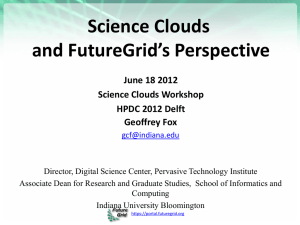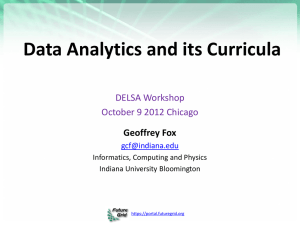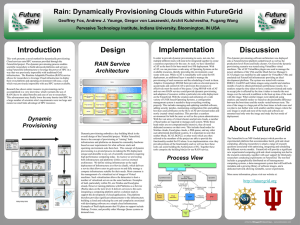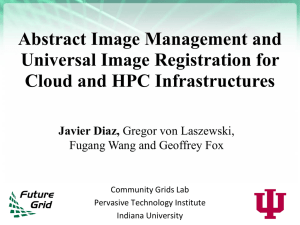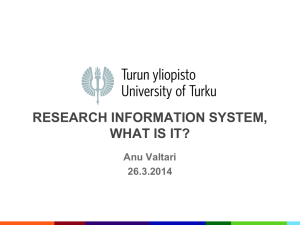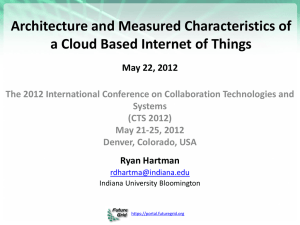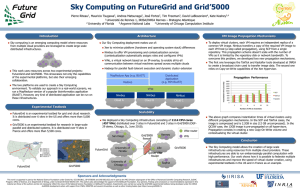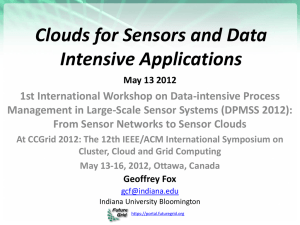Big Data in Research and Education
advertisement
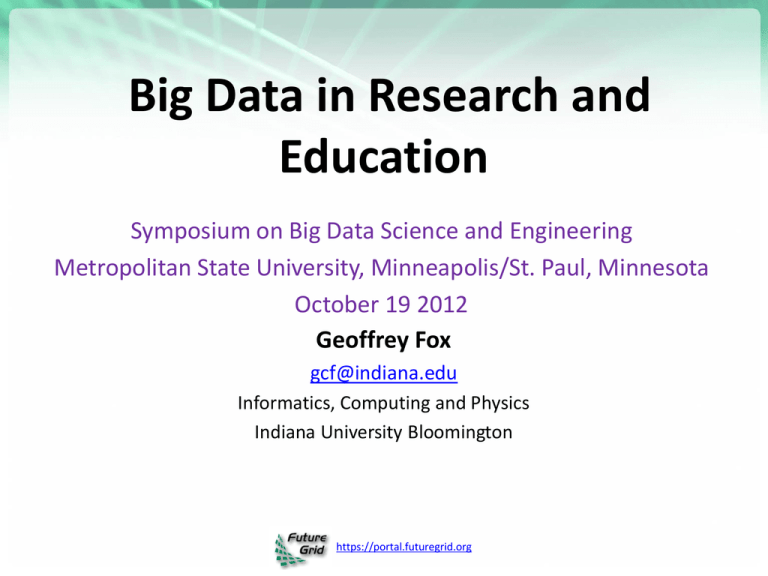
Big Data in Research and Education Symposium on Big Data Science and Engineering Metropolitan State University, Minneapolis/St. Paul, Minnesota October 19 2012 Geoffrey Fox gcf@indiana.edu Informatics, Computing and Physics Indiana University Bloomington https://portal.futuregrid.org Abstract • We discuss the sources of data from biology and medical science to particle physics and astronomy to the Internet with implications for discovery and challenges for analysis. • We describe typical data analysis computer architectures from High Performance Computing to the Cloud. • On education we look at interdisciplinary programs from computational science to flavors of informatics. • The possibility of "data science" as an academic discipline is looked at in detail as is the Program in Informatics at Indiana University. https://portal.futuregrid.org 2 Topics Covered • • • • • • • • • • Broad Overview: Data Deluge to Clouds Clouds Grids and HPC Cloud applications Analytics and Parallel Computing on Clouds and HPC Data (Analytics) Architectures Data Science and Data Analytics Informatics at Indiana University FutureGrid Computing Testbed as a Service Conclusions https://portal.futuregrid.org 3 Broad Overview: Data Deluge to Clouds https://portal.futuregrid.org 4 Some Trends The Data Deluge is clear trend from Commercial (Amazon, ecommerce) , Community (Facebook, Search) and Scientific applications Light weight clients from smartphones, tablets to sensors Multicore reawakening parallel computing Exascale initiatives will continue drive to high end with a simulation orientation Clouds with cheaper, greener, easier to use IT for (some) applications New jobs associated with new curricula Clouds as a distributed system (classic CS courses) Data Analytics (Important theme in academia and industry) Network/Web Science https://portal.futuregrid.org 5 Some Data sizes ~40 109 Web pages at ~300 kilobytes each = 10 Petabytes Youtube 48 hours video uploaded per minute; in 2 months in 2010, uploaded more than total NBC ABC CBS ~2.5 petabytes per year uploaded? LHC 15 petabytes per year Radiology 69 petabytes per year Square Kilometer Array Telescope will be 100 terabits/second Earth Observation becoming ~4 petabytes per year Earthquake Science – few terabytes total today PolarGrid – 100’s terabytes/year Exascale simulation data dumps – terabytes/second https://portal.futuregrid.org 6 Why need cost effective Computing! Full Personal Genomics: 3 petabytes per day https://portal.futuregrid.org Clouds Offer From different points of view • Features from NIST: – On-demand service (elastic); – Broad network access; – Resource pooling; – Flexible resource allocation; – Measured service • Economies of scale in performance and electrical power (Green IT) • Powerful new software models – Platform as a Service is not an alternative to Infrastructure as a Service – it is instead an incredible valued added – Amazon is as much PaaS as Azure https://portal.futuregrid.org 8 Jobs v. Countries https://portal.futuregrid.org 9 McKinsey Institute on Big Data Jobs • There will be a shortage of talent necessary for organizations to take advantage of big data. By 2018, the United States alone could face a shortage of 140,000 to 190,000 people with deep analytical skills as well as 1.5 million managers and analysts with the know-how to use the analysis of big data to make effective decisions. https://portal.futuregrid.org 10 Some Sizes in 2010 • http://www.mediafire.com/file/zzqna34282frr2f/ko omeydatacenterelectuse2011finalversion.pdf • 30 million servers worldwide • Google had 900,000 servers (3% total world wide) • Google total power ~200 Megawatts – < 1% of total power used in data centers (Google more efficient than average – Clouds are Green!) – ~ 0.01% of total power used on anything world wide • Maybe total clouds are 20% total world server count (a growing fraction) https://portal.futuregrid.org 11 Some Sizes Cloud v HPC • Top Supercomputer Sequoia Blue Gene Q at LLNL – 16.32 Petaflop/s on the Linpack benchmark using 98,304 CPU compute chips with 1.6 million processor cores and 1.6 Petabyte of memory in 96 racks covering an area of about 3,000 square feet – 7.9 Megawatts power • Largest (cloud) computing data centers – 100,000 servers at ~200 watts per CPU chip – Up to 30 Megawatts power • So largest supercomputer is around 1-2% performance of total cloud computing systems with Google ~20% total https://portal.futuregrid.org 12 Clouds Grids and HPC https://portal.futuregrid.org 13 2 Aspects of Cloud Computing: Infrastructure and Runtimes • Cloud infrastructure: outsourcing of servers, computing, data, file space, utility computing, etc.. • Cloud runtimes or Platform: tools to do data-parallel (and other) computations. Valid on Clouds and traditional clusters – Apache Hadoop, Google MapReduce, Microsoft Dryad, Bigtable, Chubby and others – MapReduce designed for information retrieval but is excellent for a wide range of science data analysis applications – Can also do much traditional parallel computing for data-mining if extended to support iterative operations – Data Parallel File system as in HDFS and Bigtable https://portal.futuregrid.org Infrastructure, Platforms, Software as a Service SaaS PaaS Ia a S System e.g. SQL, GlobusOnline Applications e.g. Amber, Blast • Software Services are building blocks of applications Cloud e.g. MapReduce • The middleware or computing HPC e.g. PETSc, SAGA environment Computer Science e.g. Languages, Sensor nets Nimbus, Hypervisor Eucalyptus, Bare Metal OpenStack Operating System Virtual Clusters, Networks • OpenNebula CloudStack https://portal.futuregrid.org 15 Science Computing Environments • Large Scale Supercomputers – Multicore nodes linked by high performance low latency network – Increasingly with GPU enhancement – Suitable for highly parallel simulations • High Throughput Systems such as European Grid Initiative EGI or Open Science Grid OSG typically aimed at pleasingly parallel jobs – Can use “cycle stealing” – Classic example is LHC data analysis • Grids federate resources as in EGI/OSG or enable convenient access to multiple backend systems including supercomputers – Portals make access convenient and – Workflow integrates multiple processes into a single job • Specialized visualization, shared memory parallelization etc. machines https://portal.futuregrid.org 16 Clouds HPC and Grids • Synchronization/communication Performance Grids > Clouds > Classic HPC Systems • Clouds naturally execute effectively Grid workloads but are less clear for closely coupled HPC applications • Classic HPC machines as MPI engines offer highest possible performance on closely coupled problems • Likely to remain in spite of Amazon cluster offering • Service Oriented Architectures portals and workflow appear to work similarly in both grids and clouds • May be for immediate future, science supported by a mixture of – Clouds – some practical differences between private and public clouds – size and software – High Throughput Systems (moving to clouds as convenient) – Grids for distributed data and access – Supercomputers (“MPI Engines”) going to exascale https://portal.futuregrid.org Cloud Applications https://portal.futuregrid.org 18 What Applications work in Clouds • Pleasingly (moving to modestly) parallel applications of all sorts with roughly independent data or spawning independent simulations – Long tail of science and integration of distributed sensors • Commercial and Science Data analytics that can use MapReduce (some of such apps) or its iterative variants (most other data analytics apps) • Which science applications are using clouds? – Venus-C (Azure in Europe): 27 applications not using Scheduler, Workflow or MapReduce (except roll your own) – 50% of applications on FutureGrid are from Life Science – Locally Lilly corporation is commercial cloud user (for drug discovery) – Nimbus applications in bioinformatics, high energy physics, nuclear physics, astronomy and ocean sciences https://portal.futuregrid.org 19 27 Venus-C Azure Applications Chemistry (3) Civil Protection (1) Biodiversity & Biology (2) • Lead Optimization in Drug Discovery • Molecular Docking • Fire Risk estimation and fire propagation • Biodiversity maps in marine species • Gait simulation Civil Eng. and Arch. (4) • Structural Analysis • Building information Management • Energy Efficiency in Buildings • Soil structure simulation Physics (1) • Simulation of Galaxies configuration Earth Sciences (1) • Seismic propagation Mol, Cell. & Gen. Bio. (7) • • • • • Genomic sequence analysis RNA prediction and analysis System Biology Loci Mapping Micro-arrays quality. ICT (2) • Logistics and vehicle routing • Social networks analysis Medicine (3) • Intensive Care Units decision support. • IM Radiotherapy planning. • Brain Imaging Mathematics (1) • Computational Algebra Mech, Naval & Aero. Eng. (2) • Vessels monitoring • Bevel gear manufacturing simulation https://portal.futuregrid.org 20 VENUS-C Final Review: The User Perspective 11-12/7 EBC Brussels Parallelism over Users and Usages • “Long tail of science” can be an important usage mode of clouds. • In some areas like particle physics and astronomy, i.e. “big science”, there are just a few major instruments generating now petascale data driving discovery in a coordinated fashion. • In other areas such as genomics and environmental science, there are many “individual” researchers with distributed collection and analysis of data whose total data and processing needs can match the size of big science. • Clouds can provide scaling convenient resources for this important aspect of science. • Can be map only use of MapReduce if different usages naturally linked e.g. exploring docking of multiple chemicals or alignment of multiple DNA sequences – Collecting together or summarizing multiple “maps” is a simple Reduction https://portal.futuregrid.org 21 Internet of Things and the Cloud • It is projected that there will be 24 billion devices on the Internet by 2020. Most will be small sensors that send streams of information into the cloud where it will be processed and integrated with other streams and turned into knowledge that will help our lives in a multitude of small and big ways. • The cloud will become increasing important as a controller of and resource provider for the Internet of Things. • As well as today’s use for smart phone and gaming console support, “Intelligent River” “smart homes” and “ubiquitous cities” build on this vision and we could expect a growth in cloud supported/controlled robotics. • Some of these “things” will be supporting science • Natural parallelism over “things” • “Things” are distributed and so form a Grid https://portal.futuregrid.org 22 Cloud based robotics from Googlehttps://portal.futuregrid.org 23 Sensors (Things) as a Service Output Sensor Sensors as a Service A larger sensor ……… Sensor Processing as a Service (could use MapReduce) https://portal.futuregrid.org https://sites.google.com/site/opensourceiotcloud/ Open Source Sensor (IoT) Cloud Analytics and Parallel Computing on Clouds and HPC https://portal.futuregrid.org 25 • Classic Parallel Computing HPC: Typically SPMD (Single Program Multiple Data) “maps” typically processing particles or mesh points interspersed with multitude of low latency messages supported by specialized networks such as Infiniband and technologies like MPI – Often run large capability jobs with 100K (going to 1.5M) cores on same job – National DoE/NSF/NASA facilities run 100% utilization – Fault fragile and cannot tolerate “outlier maps” taking longer than others • Clouds: MapReduce has asynchronous maps typically processing data points with results saved to disk. Final reduce phase integrates results from different maps – Fault tolerant and does not require map synchronization – Map only useful special case • HPC + Clouds: Iterative MapReduce caches results between “MapReduce” steps and supports SPMD parallel computing with large messages as seen in parallel kernels (linear algebra) in clustering and other data mining https://portal.futuregrid.org 26 4 Forms of MapReduce (a) Map Only Input (b) Classic MapReduce (c) Iterative MapReduce Input Input (d) Loosely Synchronous Iterations map map map Pij reduce reduce Output BLAST Analysis High Energy Physics Expectation maximization Classic MPI Parametric sweep (HEP) Histograms Clustering e.g. Kmeans PDE Solvers and Pleasingly Parallel Distributed search Linear Algebra, Page Rank particle dynamics Domain of MapReduce and Iterative Extensions MPI Science Clouds Exascale https://portal.futuregrid.org 27 Commercial “Web 2.0” Cloud Applications • Internet search, Social networking, e-commerce, cloud storage • These are larger systems than used in HPC with huge levels of parallelism coming from – Processing of lots of users or – An intrinsically parallel Tweet or Web search • Classic MapReduce is suitable (although Page Rank component of search is parallel linear algebra) • Data Intensive • Do not need microsecond messaging latency https://portal.futuregrid.org 28 Data Analytics Futures? • PETSc and ScaLAPACK and similar libraries very important in supporting parallel simulations • Need equivalent Data Analytics libraries • Include datamining (Clustering, SVM, HMM, Bayesian Nets …), image processing, information retrieval including hidden factor analysis (LDA), global inference, dimension reduction – Many libraries/toolkits (R, Matlab) and web sites (BLAST) but typically not aimed at scalable high performance algorithms • Should support clouds and HPC; MPI and MapReduce – Iterative MapReduce an interesting runtime; Hadoop has many limitations • Need a coordinated Academic Business Government Collaboration to build robust algorithms that scale well – Crosses Science, Business Network Science, Social Science • Propose to build community to define & implement SPIDAL or Scalable Parallel Interoperable Data Analytics Library https://portal.futuregrid.org 29 Data Architectures https://portal.futuregrid.org 30 Clouds as Support for Data Repositories? • The data deluge needs cost effective computing – Clouds are by definition cheapest – Need data and computing co-located • Shared resources essential (to be cost effective and large) – Can’t have every scientists downloading petabytes to personal cluster • Need to reconcile distributed (initial source of ) data with shared analysis – Can move data to (discipline specific) clouds – How do you deal with multi-disciplinary studies • Data repositories of future will have cheap data and elastic cloud analysis support? – Hosted free if data can be used commercially? https://portal.futuregrid.org 31 Architecture of Data Repositories? • Traditionally governments set up repositories for data associated with particular missions – For example EOSDIS (Earth Observation), GenBank (Genomics), NSIDC (Polar science), IPAC (Infrared astronomy) – LHC/OSG computing grids for particle physics • This is complicated by volume of data deluge, distributed instruments as in gene sequencers (maybe centralize?) and need for intense computing like Blast – i.e. repositories need lots of computing? https://portal.futuregrid.org 32 Traditional File System? Data S Data Data Archive Data C C C C S C C C C S C C C C C C C C S Storage Nodes Compute Cluster • Typically a shared file system (Lustre, NFS …) used to support high performance computing • Big advantages in flexible computing on shared data but doesn’t “bring computing to data” • Object stores similar structure (separate data and compute) to this https://portal.futuregrid.org Data Parallel File System? Block1 Replicate each block Block2 File1 Breakup …… BlockN Data C Data C Data C Data C Data C Data C Data C Data C Data C Data C Data C Data C Data C Data C Data C Data C Block1 Block2 File1 Breakup …… Replicate each block BlockN https://portal.futuregrid.org • No archival storage and computing brought to data What is Data Analytics and Data Science? https://portal.futuregrid.org 35 Data Analytics/Science • Broad Range of Topics from Policy to new algorithms • Enables X-Informatics where several X’s defined especially in Life Sciences – Medical, Bio, Chem, Health, Pathology, Astro, Social, Business, Security, Crisis, Intelligence Informatics defined (more or less) – Could invent Life Style (e.g. IT for Facebook), Radar …. Informatics – Physics Informatics ought to exist but doesn’t • Plenty of Jobs and broader range of possibilities than computational science but similar issues – What type of degree (Certificate, track, “real” degree) – What type of program (department, interdisciplinary group supporting education and research program) https://portal.futuregrid.org 36 https://portal.futuregrid.org Computational Science • Interdisciplinary field between computer science and applications with primary focus on simulation areas • Very successful as a research area – XSEDE and Exascale systems enable • Several academic programs but these have been less successful as – No consensus as to curricula and jobs (don’t appoint faculty in computational science; do appoint to DoE labs) – Field relatively small • Started around 1990 • Note Computational Chemistry is typical part of Computational Science (and chemistry) whereas Cheminformatics is part of Informatics and data science – Here Computational Chemistry much larger than Cheminformatics but – Typically data side larger than simulations https://portal.futuregrid.org 38 Data Science is also Information/Knowledge/Wisdom/Decision Science? Data Information Knowledge Wisdom Decisions S S Another Grid Another Grid S S S S fs SS fs fs SS S S S S fs S S Compute Cloud Database fs fs fs S S S S fs Filter Service fs fs Filter Service fs SS SS Filter Cloud fs fs Filter Cloud Another Grid fs Filter Cloud fs SS Discovery Cloud fs fs Filter Service fs fs fs SS SS fs Filter Service fs Filter Cloud Another Service S S Raw Data S S fs Filter Cloud S S https://portal.futuregrid.org Discovery Cloud fs Traditional Grid with exposed services Filter Cloud S S S S Storage Cloud S S Sensor or Data Interchange Service Data Science General Remarks I • An immature (exciting) field: No agreement as to what is data analytics and what tools/computers needed – Databases or NOSQL? – Shared repositories or bring computing to data – What is repository architecture? • Sources: Data from observation or simulation • Different terms: Data analysis, Datamining, Data analytics., machine learning, Information visualization, Data Science • Fields: Computer Science, Informatics, Library and Information Science, Statistics, Application Fields including Business • Approaches: Big data (cell phone interactions) v. Little data (Ethnography, surveys, interviews) • Includes: Security, Provenance, Metadata, Data Management, Curation https://portal.futuregrid.org 40 Data Science General Remarks II • Tools: Regression analysis; biostatistics; neural nets; Bayesian nets; support vector machines; classification; clustering; dimension reduction; artificial intelligence; semantic web • Some data in metric spaces; others very high dimension or none • Patient records growing fast (70PB pathology) • Complex graphs from internet studying communities/linkages • Large Hadron Collider analysis mainly histogramming – all can be done with MapReduce (larger use than MPI) • Commercial: Google, Bing largest data analytics in world • Time Series: Earthquakes, Tweets, Stock Market (Pattern Informatics) • Image Processing from climate simulations to NASA to DoD to Radiology (Radar and Pathology Informatics – same library) • Financial decision support; marketing; fraud detection; automatic preference detection (map users to books, films) https://portal.futuregrid.org 41 Program OnCampus Online Degrees Computational and Data Sciences: the combination of applied math, real world CS skills, data acquisition and analysis, and scientific modeling CS Specialization in Data Science CIS specialization in Data Science Yes No B.S. Data and Systems Analysis ? Yes Adv. Diploma Bentley University Marketing Analytics: knowledge and skills that marketing professionals need for a rapidly evolving, data-focused, global business environment. Yes ? M.S. Carnegie Mellon MISM Business Intelligence and Data Analytics: an elite set Yes of graduates cross-trained in business process analysis and skilled in predictive modeling, GIS mapping, analytical reporting, segmentation analysis, and data visualization. Carnegie Mellon Very Large Information Systems: train technologists to (a) develop the layers of technology involved in the next generation of massive IS deployments (b) analyze the data these systems generate DePaul University Predictive Analytics: analyze large datasets and develop modeling solutions for decision making, an understanding of the fundamental principles of marketing and CRM Yes ? MS. Georgia Southern University Survey from Howard Rosenbaum SLIS IU Comp Sci with concentration in Data and Know. Systems: covers speech and vision recognition systems, expert systems, data storage systems, and IR systems, such as https://portal.futuregrid.org online search engines No Yes M.S. 30 cr School Undergraduate George Mason University Illinois Institute of Technology Oxford University B.S. Masters M.S. 9 courses 42 CS specialization in Data Analytics: intended for Yes learning how to discover patterns in large amounts of data in information systems and how to use these to draw conclusions. Business Analytics: designed to meet the growing Yes demand for professionals with skills in specialized methods of predictive analytics 36 cr ? Masters 4 courses No M.S. 36 cr Michigan State University Business Analytics: courses in business strategy, data Yes mining, applied statistics, project management, marketing technologies, communications and ethics No M.S. North Carolina State University: Institute for Advanced Analytics Northwestern University Analytics: designed to equip individuals to derive insights from a vast quantity and variety of data Yes No M.S.: 30 cr. Predictive Analytics: a comprehensive and applied Yes curriculum exploring data science, IT and business of analytics Yes M.S. New York University Business Analytics: unlocks predictive potential of data analysis to improve financial performance, strategic management and operational efficiency Yes No M.S. 1 yr Stevens Institute of Technology Business Intel. & Analytics: offers the most advanced Yes curriculum available for leveraging quant methods and evidence-based decision making for optimal business performance Yes M.S.: 36 cr. University of Cincinnati Business Analytics: combines operations research Yes and applied stats, using applied math and computer applications, in a business environment No M.S. University of San Francisco Analytics: provides students with skills necessary to develop techniques and processes for data-driven decision-making — the key to effective business https://portal.futuregrid.org strategies No M.S. Illinois Institute of Technology Louisiana State University businessanalytics.lsu.edu/ Yes 43 Certificate Data Science: for those with background or experience in science, stats, research, and/or IT interested in interdiscip work managing big data using IT tools Big Data Summer Institute: organized to address a growing demand for skills that will help individuals and corporations make sense of huge data sets Data Mining and Applications: introduces important new ideas in data mining and machine learning, explains them in a statistical framework, and describes their applications to business, science, and technology Yes ? Grad Cert. 5 courses Yes No Cert. No Yes Grad Cert. University of California San Diego Data Mining: designed to provide individuals in business and scientific communities with the skills necessary to design, build, verify and test predictive data models No Yes Grad Cert. 6 courses University of Washington Data Science: Develop the computer science, mathematics and analytical skills in the context of practical application needed to enter the field of data science Yes Yes Cert. George Mason University Computational Sci and Informatics: role of Yes computation in sci, math, and engineering, No Ph.D. IU SoIC https://portal.futuregrid.org Informatics No Ph.D44 iSchool @ Syracuse Rice University Stanford University Ph.D Yes Informatics at Indiana University https://portal.futuregrid.org 45 Informatics at Indiana University • School of Informatics and Computing – Computer Science – Informatics – Information and Library Science (new DILS was SLIS) • Undergraduates: Informatics ~3x Computer Science – Mean UG Hiring Salaries – Informatics $54K; CS $56.25K – Masters hiring $70K – 125 different employers 2011-2012 • Graduates: CS ~2x Informatics • DILS Graduate only, MLS main degree https://portal.futuregrid.org 46 Original Informatics Faculty at IU • • • • • • • • Security largely moving to Computer Science Bioinformatics moving to Computer Science Cheminformatics Health Informatics Music Informatics moving to Computer Science Complex Networks and Systems now =largest Human Computer Interaction Design now =largest Social Informatics • Move partly as CS rated; Informatics not • Illustrates difficulties with degrees/departments with new names https://portal.futuregrid.org Largely Applied Computer Science • Cyberinfrastructure and High Performance Computing largely in Computer Science • Data, Databases and Search in Computer Science • Image Processing/ Computer Vision in Informatics • Ubiquitous Computing Interested in adding • Robotics in Informatics • Visualization and Computer Graphics Retired in CS • These are fields you will find in many computer science departments but are focused on using computers https://portal.futuregrid.org Largely Core Computer Science • • • • Computer Architecture Computer Networking Programming Languages and Compilers Artificial Intelligence, Artificial Life and Cognitive Science • Computation Theory and Logic • Quantum Computing • These are traditional important fields of Computer Science providing ideas and tools used in Informatics and Applied Computer Science https://portal.futuregrid.org Informatics Job Titles Account Service Provider Analyst Application Consultant Application Developer Assoc. IT Business analyst Associate IT Developer Associate Software Engineer Automation Engineer Business Analyst Business Intelligence Business Systems Analyst Catapult Rotational Program Computer Consultant Computer Support Specialist Consultant Corporate Development Program Analyst Data Analytics Consultant Database and Systems Manager Delivery Consultant Designer Director of Information Systems Engineer Information Management Leadership Program Information Technology Security Consultant IT Business Process Specialist IT Early Development Program Java Programmer Junior Consultant Junior Software Engineer Lead Network Engineer Logistics Management Specialist Market Analyst https://portal.futuregrid.org 50 Informatics Job Titles Marketing Representative Mobile Developer Network Engineer Programmer Project Manager Quality Assurance Analyst Research Programmer Security and Privacy Consultant Social Media Mgr & Community Mgmt Software Analyst Software Consultant Software Developer Software Development Engineer Software Development Engineer in Test (SDET) Software Engineer Support Analyst Support Engineer System Administrator System integration Analyst Systems Architect Systems Engineer Systems/Data Analyst Tech Analyst Tech Consultant Tech Leadership Dev Program UI Designer User Interface Software Engineer UX Designer UX Researcher Velocity Software Engineer Velocity Systems Consultant Web Designer Web Developer https://portal.futuregrid.org 51 Undergraduate Cognates Biology Business Chemistry Cognitive Science Communication and Culture Computer Science Economics Fine Arts (2 options) Geography Human-Centered Computing Information Technology Journalism Linguistics Mathematics Medical Sciences Music Philosophy of Mind and Cognition Pre-health Professions Psychology Public and Environmental Affairs (5 options) Public Health Security Telecommunications (3 options) https://portal.futuregrid.org 52 Data Science at Indiana University • Currently Masters in CS, Informatics, HCI, Bioinformatics, Security Informatics and will add Information and Library Science (ILS) • Propose to add a Masters in Data Science (~30 cr.) with courses covering CS, Informatics, ILS – – – – Data Lifecycle (~ILS) Data Analysis (~CS) Data Management (~CS and ILS) Applications (X Informatics) (~Informatics) • Also minor/certificates • Number of courses in each category being debated – Existing programs would like their courses required – i.e. as always political and technical issues in decisions https://portal.futuregrid.org 53 Massive Open Online Courses (MOOC) • MOOC’s are very “hot” these days with Udacity and Coursera as start-ups • Over 100,000 participants but concept valid at smaller sizes • Relevant to Data Science as this is a new field with few courses at most universities • Technology to make MOOC’s – Drupal mooc (unclear it’s real) – Google Open Source Course Builder is lightweight LMS (learning management system) released September 12 rescuing us from Sakai • At least one MOOC model is collection of short prerecorded segments (talking head over PowerPoint) https://portal.futuregrid.org 54 I400 X-Informatics (MOOC) • General overview of “use of IT” (data analysis) in “all fields” starting with data deluge and pipeline • ObservationDataInformationKnowledgeWisdom • Go through many applications from life/medical science to “finding Higgs” and business informatics • Describe cyberinfrastructure needed with visualization, security, provenance, portals, services and workflow • Lab sessions built on virtualized infrastructure (appliances) • Describe and illustrate key algorithms histograms, clustering, Support Vector Machines, Dimension Reduction, Hidden Markov Models and Image processing https://portal.futuregrid.org 55 FutureGrid https://portal.futuregrid.org 56 FutureGrid key Concepts I • FutureGrid is an international testbed modeled on Grid5000 – September 21 2012: 260 Projects, ~1360 users • Supporting international Computer Science and Computational Science research in cloud, grid and parallel computing (HPC) • The FutureGrid testbed provides to its users: – A flexible development and testing platform for middleware and application users looking at interoperability, functionality, performance or evaluation – FutureGrid is user-customizable, accessed interactively and supports Grid, Cloud and HPC software with and without VM’s – A rich education and teaching platform for classes • See G. Fox, G. von Laszewski, J. Diaz, K. Keahey, J. Fortes, R. Figueiredo, S. Smallen, W. Smith, A. Grimshaw, FutureGrid - a reconfigurable testbed for Cloud, HPC and Grid Computing, https://portal.futuregrid.org Bookchapter – draft FutureGrid key Concepts II • Rather than loading images onto VM’s, FutureGrid supports Cloud, Grid and Parallel computing environments by provisioning software as needed onto “bare-metal” using Moab/xCAT (need to generalize) – Image library for MPI, OpenMP, MapReduce (Hadoop, (Dryad), Twister), gLite, Unicore, Globus, Xen, ScaleMP (distributed Shared Memory), Nimbus, Eucalyptus, OpenNebula, KVM, Windows ….. – Either statically or dynamically • Growth comes from users depositing novel images in library • FutureGrid has ~4400 distributed cores with a dedicated network and a Spirent XGEM network fault and delay generator Image1 Image2 ImageN … Choose https://portal.futuregrid.org Load Run FutureGrid Grid supports Cloud Grid HPC Computing Testbed as a Service (aaS) 12TF Disk rich + GPU 512 cores NID: Network Impairment Device Private FG Network Public https://portal.futuregrid.org 59 FutureGrid Distributed Testbed-aaS Bravo Delta (IU) India (IBM) and Xray (Cray) (IU) Hotel (Chicago) https://portal.futuregrid.org Foxtrot (UF) Sierra (SDSC) Alamo (TACC)60 Compute Hardware Total RAM # CPUs # Cores TFLOPS (GB) Secondary Storage (TB) Site IU Name System type india IBM iDataPlex 256 1024 11 3072 180 alamo Dell PowerEdge 192 768 8 1152 30 hotel IBM iDataPlex 168 672 7 2016 120 sierra IBM iDataPlex 168 672 7 2688 96 xray Cray XT5m 168 672 6 1344 180 IU Operational foxtrot IBM iDataPlex 64 256 2 768 24 UF Operational Bravo Large Disk & memory 192 (12 TB per Server) IU Operational Delta Large Disk & 192+ 32 CPU memory With 14336 32 GPU’s Tesla GPU’s GPU 32 128 1.5 ?9 3072 (192GB per node) 1536 (192GB per node) Status Operational TACC Operational UC Operational SDSC Operational 192 (12 TB per Server) IU Operational Echo (ScaleMP) Large Disk & Memory 32 CPU 192 2 6144 192 IU On Order Lima SSD 16 128 1.3 512 3.8 (SSD) 8 (disk) SDSC On Order https://portal.futuregrid.org FutureGrid Partners • Indiana University (Architecture, core software, Support) • San Diego Supercomputer Center at University of California San Diego (INCA, Monitoring) • University of Chicago/Argonne National Labs (Nimbus) • University of Florida (ViNE, Education and Outreach) • University of Southern California Information Sciences (Pegasus to manage experiments) • University of Tennessee Knoxville (Benchmarking) • University of Texas at Austin/Texas Advanced Computing Center (Portal) • University of Virginia (OGF, XSEDE Software stack) • Center for Information Services and GWT-TUD from Technische Universtität Dresden. (VAMPIR) • Red institutions have FutureGrid hardware https://portal.futuregrid.org Recent Projects https://portal.futuregrid.org 63 4 Use Types for FutureGrid TestbedaaS • 260 approved projects (1360 users) September 21 2012 – USA, China, India, Pakistan, lots of European countries – Industry, Government, Academia • Training Education and Outreach (10%) – Semester and short events; interesting outreach to HBCU • Computer science and Middleware (59%) – Core CS and Cyberinfrastructure; Interoperability (2%) for Grids and Clouds; Open Grid Forum OGF Standards Fractions are as • Computer Systems Evaluation (29%) of July 15 2012 – XSEDE (TIS, TAS), OSG, EGI; Campuses add to > 100% • New Domain Science applications (26%) – Life science highlighted (14%), Non Life Science (12%) – Generalize to building Research Computing-aaS https://portal.futuregrid.org 64 Computing Testbed as a Service https://portal.futuregrid.org 65 FutureGrid offers Computing Testbed as a Service Research Computing aaS SaaS PaaS IaaS Custom Images Courses Consulting Portals Archival Storage System e.g. SQL, GlobusOnline Applications e.g. Amber, Blast Cloud e.g. MapReduce HPC e.g. PETSc, SAGA Computer Science e.g. Languages, Sensor nets Hypervisor Bare Metal Operating System Virtual Clusters, Networks https://portal.futuregrid.org • • • • FutureGrid Uses Testbed-aaS Tools Provisioning Image Management IaaS Interoperability IaaS tools Expt management Dynamic Network Devops FutureGrid Usages Computer Science Applications and understanding Science Clouds Technology Evaluation including XSEDE testing Education and 66 Training Research Computing as a Service • Traditional Computer Center has a variety of capabilities supporting (scientific computing/scholarly research) users. – Could also call this Computational Science as a Service • IaaS, PaaS and SaaS are lower level parts of these capabilities but commercial clouds do not include 1) Developing roles/appliances for particular users 2) Supplying custom SaaS aimed at user communities 3) Community Portals 4) Integration across disparate resources for data and compute (i.e. grids) 5) Data transfer and network link services 6) Archival storage, preservation, visualization 7) Consulting on use of particular appliances and SaaS i.e. on particular software components 8) Debugging and other problem solving 9) Administrative issues such as (local) accounting • This allows us to develop a new model of a computer center where commercial companies operate base hardware/software • A combination of XSEDE, Internet2 and computer center supply 1) to 9)? https://portal.futuregrid.org 67 Expanding Resources in FutureGrid • We have a core set of resources but need to keep up to date and expand in size • Natural is to build large systems and support large experiments by federating hardware from several sources – Requirement is that partners in federation agree on and develop together TestbedaaS • Infrastructure includes networks, devices, edge (client) equipment https://portal.futuregrid.org 68 Conclusion https://portal.futuregrid.org 69 Conclusions • Does Cloud + MPI Engine for computing + grids for data cover all? – Merge high throughput computing and cloud concepts? • Need interoperable data analytics libraries for HPC and Clouds that address new robustness and scaling challenges of big data • Can we characterize data analytics applications? – I said modest size and kernels need reduction operations and are often full matrix linear algebra (true?) • Is Research Computing as a Service interesting? • CTaaS (Computing Testbed as a Service) and Federated resources • More employment opportunities in clouds than HPC and Grids and in data than simulation; so cloud and data related activities popular with students • International activity to discuss data science education – Agree on curricula; is such a degree attractive? https://portal.futuregrid.org 70
